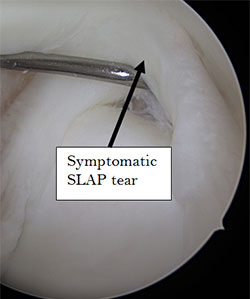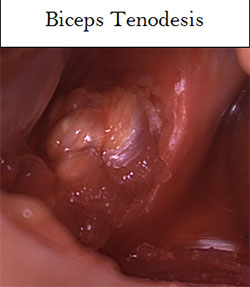Superior Labral Anterior-Posterior (SLAP) Tears
Anatomy and function of the superior labrum
The shoulder is a ball-and-socket joint between the upper arm bone, which is called the humerus, and the shoulder blade, which is called the scapula. The ball is on the top of the upper arm bone and the socket is on the shoulder blade. The socket is made deeper by the labrum. The labrum is a triangle of soft bendable cartilage, similar to the cartilage in the ear and the nose, that runs around the socket. The labrum on the top half of the socket is called the superior labrum. This portion serves as the attachment site for one of the two biceps tendons.
Superior labral (SLAP) tears

The superior labrum can be torn from the socket of the shoulder. These tears typically extend forward and backwards (i.e. anteriorly and posteriorly), and are thuscalled superior labral anterior-posterior or SLAP tears. There are several potential causes for SLAP tears. SLAP tears can occur with trauma such as a fall or car accident. SLAP tears can also occur with tears of the lower labrum as a result of shoulder dislocations. In these settings, SLAP tears often create pain in the back or top of the shoulder and can also create painful clunking sensations in the shoulder. Because the biceps tendon attaches to the superior labrum, tendonitis of the biceps tendon can occur with SLAP tears, which can cause pain in the front of the shoulder radiating down the arm.

However, not all SLAP tears create symptoms. The overhead throwing motion may create SLAP tears in baseball players, softball players and other overhead athletes. Studies have shown these “tears” to be common in baseball pitchers without shoulder pain playing without limitations. SLAP tears can also occur as a normal part of aging. Studies have shown these “tears” to be common in those over the age of 40 without shoulder pain or problems. SLAP tears can be “asymptomatic” because the superior labrum plays only a very small role in shoulder function.
Diagnosis of SLAP tears

SLAP tears are most frequently diagnosed using MRI. However, an MRI diagnosis of a SLAP tear does not confirm that the SLAP tear contributes to shoulder pain. Most SLAP tears are diagnosed “incidentally”. In each case, Dr. Chalmers will ask questions, examine the shoulder, and often request guided injections to diagnose symptomatic SLAP tears.
Treatment of SLAP tears
Because most SLAP tears are asymptomatic, many do not require specific treatment. Instead, the treatment may focus on other causes of pain in the shoulder. In those SLAP tears that are symptomatic, Dr. Chalmers often recommends a guided injection and physical therapy to strength the rotator cuff muscles and the muscles that stabilize the shoulder blade. These can be very successful in making SLAP tears asymptomatic. Not all SLAP tears require surgery.
Surgery


Dr. Chalmers rarely recommends surgery for SLAP tears. There are two basic surgical treatments available for SLAP tears. Both types of surgery can usually be performed through an arthroscopy.
In the first option, Dr. Chalmers repairs the labrumback to socket using sutures and anchors. Special extra-strength sutures attach to anchors, which are also made up of suture. These sutures are not absorbable, but will cover with scar tissue and do not need to be removed. This treatment leaves the biceps tendon attached to the labrum and is only recommended in very young people if there is no inflammation in the biceps.
In the second option, Dr. Chalmers will cut the biceps tendon from the labrum, remove the inflamed and irritated portion of the biceps tendon and reattach the tendon to the upper arm bone. This procedure is called a biceps tenodesis. It does not alter the appearance of the arm or the strength in the biceps and can be performed even in high level athletes and throwers.
Click here to download the PDF
You will need the Adobe Reader to view and print these documents 
